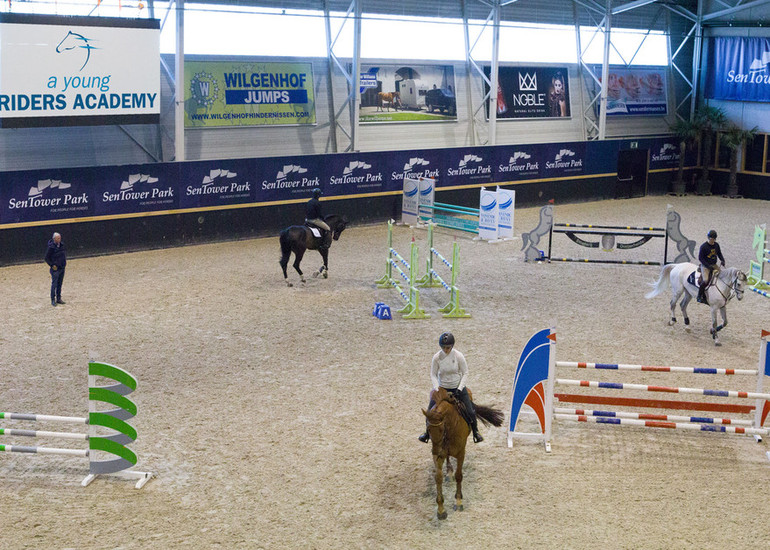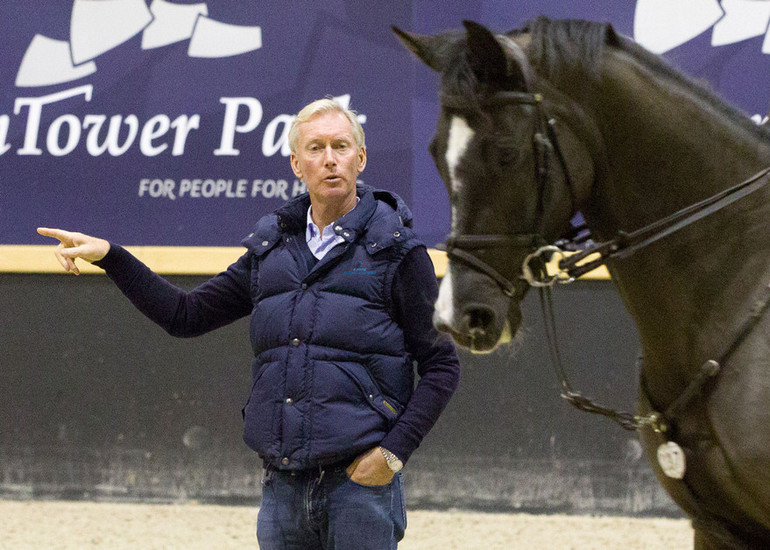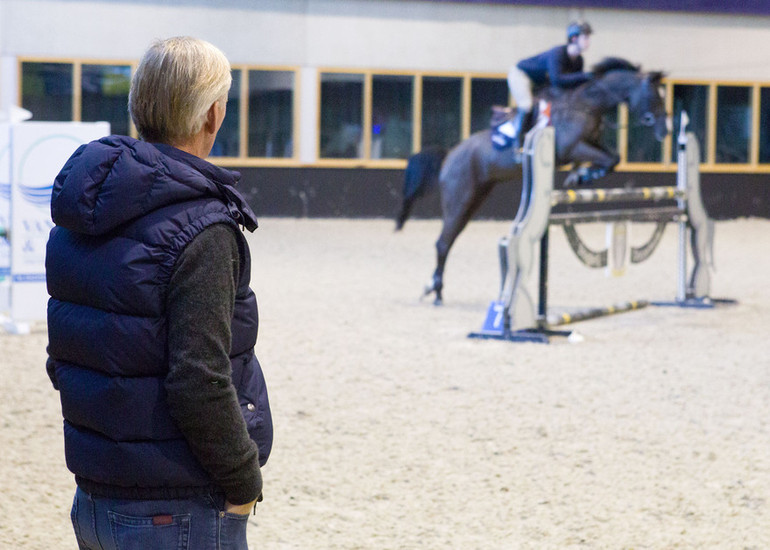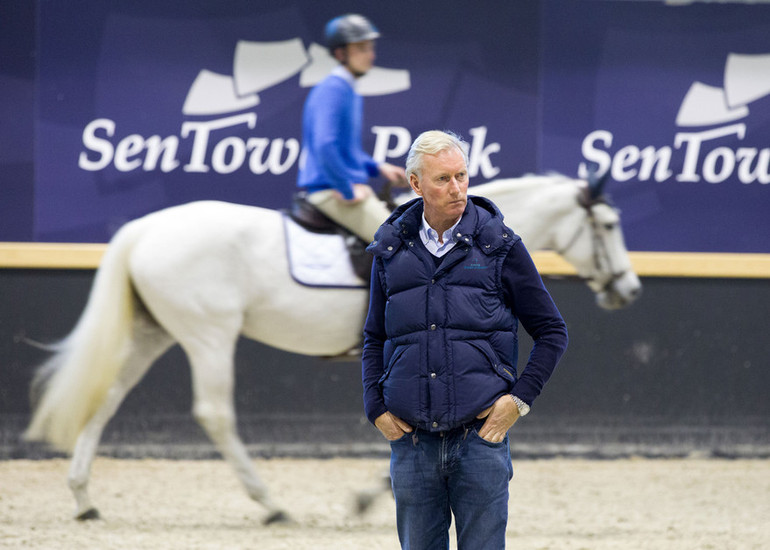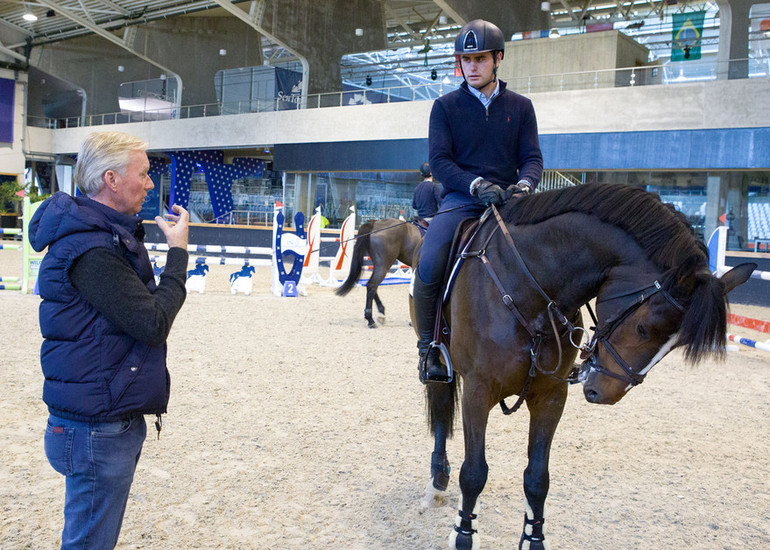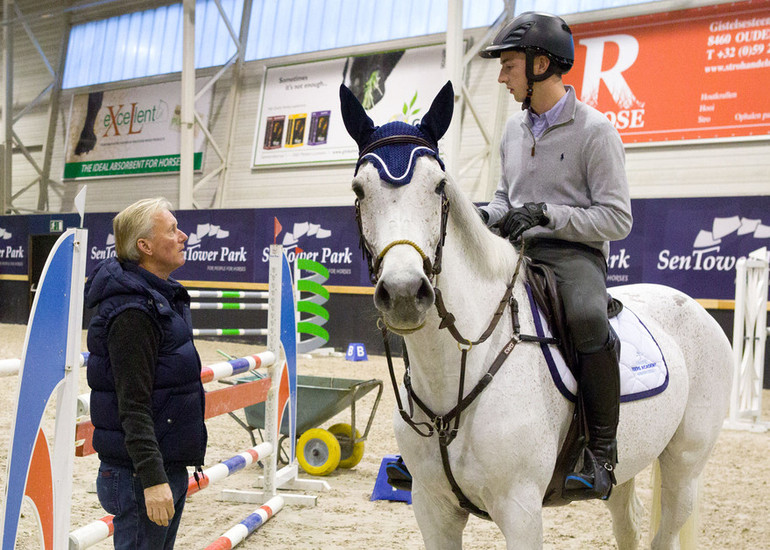Education for the future
It’s a cold November day at Sentower Park in Belgium, with the thermostat close to minus degrees. Inside however, horses and riders are sweating. They are training under the guidance of former World Champion Jos Lansink, who is in charge of a three-day clinic here in Belgium initiated by A Young Riders Academy.* Some of Europe’s most talented young riders have gathered here, and are overseen not only by Lansink – but also by legends like Henk Nooren and Emile Hendrix that drop in to have a look at their students.
“Most of the riders here have as a goal to one day be in the Top 10. Some of them maybe will, some of them maybe won’t. Getting there is not only about being a good rider and having the talent. You also need the right horses at the right time, of course sponsors – and a lot of other circumstantial factors that will help bring you there. At these YRA clinics, I want to focus on giving the riders the right tools for a sustainable career – without necessarily being in the Top 10. For many riders, building up horses and selling them to other riders – that maybe are in the Top 10 – is a perfectly fine way of making a living. But to sell a horse to other top riders, it needs to be educated and build up right so it is strong enough for the highest level of the sport. This is what I try to teach the riders here, so that they can educate horses for the future,” Lansink says.
Simplicity
Lansink’s focus is on simplicity. In the flatwork, the riders work on transitions – trot to canter, canter to trot, on straight lines and on smaller circles. The work moves between collection and relaxation, in repeating patterns. “Keep your upper body long, your legs long,” Lansink says to the riders about their position. “Sit, sit, sit and stay around your horse with your leg on to keep the connection. This is important, we are working towards connection,” Lansink repeats.
No collecting exercise lasts for long, the riders quickly need to move their horses into a more forward rhythm and with a light seat. “Make the horses relaxed, not more tense,” Lansink says. “Don’t collect the horses by shortening their necks, keep their necks long and make them come on to their hind legs – we don’t want them behind the bit. And don’t collect just by going slower, get the horses more active behind through the collection,” Lansink tells the riders. “Get the horses between your hands and legs, get them under you – make them work behind the saddle.”
When it is time to start jumping, Lansink continues to keep it simple. It’s about focus on where to ride and how to ride. Lansink asks the riders to use every inch of the indoor to give themselves and the horses time, no lines un-straight and no corners cut. Precision is the key. “Keep the horses between the hand and the leg, keep them straight and forward and use the corners,” Lansink messages out as the riders start jumping small uprights with canter poles behind placed out as a small course the size of a 20 x 20 circle. “Take your time, don’t over-ride,” Lansink says again and again.
“Use the corners to relax your horse, and use the poles after the jump to keep them straight in the landing. What is important is that the horses land on the right leg, that you use the corners and keep them through in their body. Jump every fence nice in the middle. Play around, don’t make it difficult,’ Lansink says as it progressively gets harder with more fences added in the form of a short course.
Focus on the basics
“The most important thing are the basics,” Lansink says to World of Showjumping after. “You see it often at the shows: The kids, they can ride very fast but when there sometimes is a question in the ring where they have to show the control – there is none. This creates problems when the classes get bigger: Then you have to have the control. Otherwise the horses get scared, or you will have accidents.”
“You can make simple things, like poles on the ground, very difficult,” Lansink says about how he makes the riders focus on getting control. “Small fences with a distance where you make one extra stride or one stride less. Then for example, after leaving out a stride add on the next line – to show the control after having a forward distance. This way you test if the horse is listening to the rider, and the rider shows he or she knows what to do."
"These are the most important things I believe. I like to see the riders getting things back under control, and using their time between the fences to do so – there is no time allowed here today,” Lansink smiles when talking about his demand for accuracy.
“To do this you also need to work on transitions in the flatwork, lengthening and shortening the horse – in trot and canter, but also transition between trot and canter,” Lansink explains.
Don't fight
With one of the horses being a bit spooky on the short side towards one of the small uprights, Lansink asked the rider to stay calm and take his time – rather than kicking or arguing. “It makes no sense that a rider who has a particular problem like that starts to chase towards the fence,” Lansink says. “It makes the horse more scared if it knows it gets kicked in the stomach or pulled in the mouth. It is better that the rider on top gives the right message to the horse, and says ‘Boy, today we are going to jump it like I want to jump it’ and then try to jump it by giving the horse confidence not to force it through. Then the horse and rider also get confidence in each other.”
The day after, it is time to practice a proper course. The focus however, remains the same: The riders are asked to keep their horses straight, keep in the middle of the fences, use the corners, take their time and stay in rhythm without over-riding. Between the jumps, Lansink asks for riding with collection, relaxation and rhythm before the next fence comes up. “Fix the problem, don’t think about the next fence – we are not at the show,” he says. “Work through the problem, solve it.”
Derin Demirsoy: Making the horses listen
After the course practise, World of Showjumping meets Turkish rider Derin Demirsoy – a graduate from the Academy after participating in the 2016-program. “Jos’ exercises here at the clinic are focused on making the horses listen to our aids, and especially what we did yesterday over the small jumps aims to increase their flexibility and responsiveness in the turns – we did a lot of short turns to small fences. Jos told us to ride those small fences as if they were poles on the ground, to get the horses to respect us and then think about the jump. In this way, it becomes more about the flatwork in between the jumps. When collecting the horses, Jos always asks for leg first and always more leg and seat than hand – it is about getting the right connection, sitting deep in the saddle and not just on the saddle,” Demirsoy explains.
“We all had both younger horses and more experienced horses here. Our older horses are used to jump a lot of bigger classes, these exercises over small fences benefitted them in many ways. Here we could bring their focus back to the flatwork in between the jumps – and then also just relax over the fences, and pop over without tension. I think we all saw the result of this work when jumping the course today, they were much more responsive to our aids, much more patient and not anticipating as much – they all waited and did not rush,” Demirsoy concluded. “The training here has been great!”
Michael G Duffy: It gave my horses great confidence
“I really enjoyed the clinic with Jos. I had three completely different horses there, and he gave me brilliant help and tips for them all.
As you can see from the videos, the first two days I did exercises that included a lot of flatwork over small jumps. I found this great for getting a good connection with the horses and they really relaxed and enjoyed their work.
On the third day of the clinic, I jumped a training course with my horses. In this training, Jos made sure I did everything correct – keeping my horses in a good rhythm, straight and relaxed. It gave my horses great confidence, and their jump got better and better as they went on.”
Jack Dodd: What I’ve learned
“Before I got selected for A Young Riders Academy, I thought I was a good rider. Later, I realized I was not as good as I thought,” Jack laughs.
“I started training with Marcus Ehning when I worked for Bertram Allen, and it really opened my eyes to the fact that my flatwork was not good enough at all.
What Marcus and Jos both are amazing at is adapting to every horse, it is not a system – that is not the case. To illustrate: When I moved to Jos, I had one of Bertram’s Grand Prix horses with me – quite a difficult and special horse. We were riding him a bit the American-way, light and had a hackamore on him and I remember thinking ‘I wonder how Jos is going to do this’. And he did it completely different than I thought he would. Any time the horse got difficult or strong, we would just go on a circle – never pulling against. Everything was really light, and working with the horse. Sometimes we would longe him for 15-20 minutes before I went on, just to make him really lose – and get on and canter forwards on a long rein. So, before I actually started working the horse, it was already really warm and then I could ask something. It is the same with the warming down with Jos, we spend a lot of time on that as well – often putting them in the walker 20-30 minutes after riding. Then the next day they don’t feel sore or tired.
Marcus and Jos both stress on the basics, you think it will be this big and complicated system but it is not – do the basics and do them right. ‘Keep them straight’, ‘focus on your body’, ‘use your corners’ – simple things like this. I never once got confused by Marcus or Jos. They ask you to do the simple things right. And the difference between getting the simple things right and not, is huge. Your transitions, how to do a proper transition from trot to canter or from canter to trot – it is so important that you do it the correct way.
Also, you never see Bertram, Marcus or Jos fighting with their horses – and it is one thing they all stress. They work them, and they push them – but they never fight. They are so sympathetic, working with the horses – I think it makes the horses want to jump for them.”
Jos Lansink: Motivating
It’s not only the Academy-students that are happy after three days at Sentower Park: “I really like to train them,” Lansink says. “It is very motivating!”
“What the Academy is doing is fantastic!” Lansink says. “In my days, we did everything ourselves. If we were lucky we had a home trainer. Mostly we learned from watching other riders, and seeing what they did. But copying someone else can also be dangerous and difficult, and you can also do damage this way when you don’t know what you are doing. It is different when you have someone on the floor to tell you to do this or that.”
And, does the younger generation listen well? “I think so. I hope!” Lansink laughs.
* The Young Riders Academy is a program conceived for European talented young show jumpers, under the patronage of the European Equestrian Federation (EEF), with the cooperation of the International Jumping Riders Club (IJRC) and the support of Rolex.
Founded in 2014 by Athenaeum, a non-profit association, the program will give talented riders between the ages of 18 and 23 the chance to get six months of training and boarding at a well-known professional stable. On top of that, professional education in communication, business and economics, veterinary and legal practice related to show jumping. The objective is to develop future champions as well as potential managers of this sport.
Text © World of Showjumping by Jannicke Naustdal // Pictures © Fabio Petroni / YRA
No reproduction without permission - Thanks to the YRA for making this article possible



